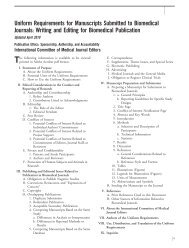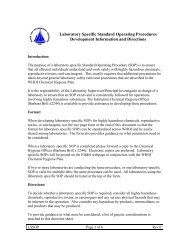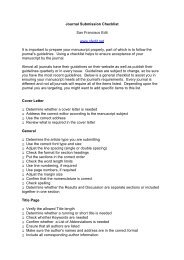Guidance for Preparing Standard Operating Procedures (SOPs)
Guidance for Preparing Standard Operating Procedures (SOPs)
Guidance for Preparing Standard Operating Procedures (SOPs)
You also want an ePaper? Increase the reach of your titles
YUMPU automatically turns print PDFs into web optimized ePapers that Google loves.
SW Sampling<br />
Rev. 1.0<br />
Date: 1/01<br />
Page 7 of 8<br />
9.3. Dip Sampler<br />
A dip sampler is useful <strong>for</strong> situations where a sample is to be recovered from an outfall<br />
pipe or along a lagoon bank where direct access is limited. The long handle on such a<br />
device allows access from a discrete location. Sampling procedures are as follows:<br />
1. Assemble the device in accordance with the manufacturer’s instructions.<br />
2. Extend the device to the sample location and collect the sample.<br />
3. Retrieve the sampler and transfer the sample to the appropriate sample container.<br />
9.4 Direct Method<br />
For streams, rivers, lakes, and other surface waters, the direct method may be utilized to<br />
collect water samples from the surface. This method is not to be used <strong>for</strong> sampling lagoons<br />
or other impoundments where contact with contaminants is a concern.<br />
Using adequate protective clothing, access the sampling station by appropriate means. For<br />
shallow stream stations, collect the sample under the water surface pointing the sample<br />
container upstream. The container must be upstream of the collector. Avoid disturbing the<br />
substrate. For lakes and other impoundments, collect the sample under the water surface<br />
avoiding surface debris and the boat wake.<br />
When using the direct method, do not use pre-preserved sample bottles as the collection<br />
method may dilute the concentration of preservative necessary <strong>for</strong> proper sample<br />
preservation.<br />
10.0 Sample Handling and Preservation<br />
10.1 Once samples have been collected:<br />
1. Transfer the sample(s) into suitable labeled sample containers.<br />
2. Preserve the sample or use pre-preserved sample bottles, when appropriate.<br />
3. Cap container, tape the cap securely to the container and then place container into<br />
plastic zip-locked plastic bag. If the latter is unavailable, use plastic bags and<br />
secure closure with tape.<br />
4. Load all sample containers into cooler(s) ensuring that bottles are not totally<br />
immersed in ice.<br />
5. Record all pertinent data in the site logbook and on a field data sheet.<br />
6. Complete the chain-of-custody <strong>for</strong>m.<br />
7. Attach custody seals to the cooler prior to shipment.<br />
QA/G-6 B-7<br />
March 2001







